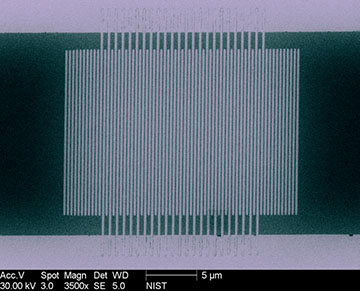Colorized micrograph of single-photon detector made of superconducting nanowires patterned on MoSi. [Image: V.B. Verma/NIST] [Enlarge image]
Researchers at the U.S. National Institute of Standards and Technology (NIST), the University of Geneva, Switzerland, and the Jet Propulsion Laboratory, USA, recently reported experiments with a new superconducting material that can snag single photons at a count rate of some ten million per second—with low system jitter (Opt. Express, doi: 10.1364/OE.23.033792).
The operating temperature of the new molybdenum-silicide (MoSi)-based detectors, while still cryogenic, could prove substantially higher than the near-absolute-zero levels required by other superconducting nanowire single-photon detectors (SNSPDs). That, in the view of the team, could give these materials a simplicity and cost advantage that could lead to their “widespread use” in applications such as quantum optics and quantum communications.
Finding the temperature-efficiency sweet spot
The work builds on previous efforts by members of the same group to build SNSPDs using alloys of tungsten and silicon (WSi). Those materials, while showing very high detection efficiency (93 percent) at telecom wavelengths (1,550 nm), only did so at very low temperatures (e.g., less than 0.15 K). They also showed comparatively high, 150-ps levels of system “jitter”—a measure of the arrival-time uncertainty of a given photon detection.
The disdavantages of the WSi detectors put the U.S.-Swiss team on the trail of other amorphous materials, in the hope of striking a better balance among efficiency, jitter and operating temperature. They focused on MoSi, a material that was known to have a higher critical temperature for superconductivity than WSi, but that had not yet achieved high efficiencies in single-photon detection.
Optimized optical cavity
The scientists built the new detector by sputter-depositing a 6.6-nm-thick MoSi film on top of a gold-SiO2 optical stack, calibrated to act as an optical cavity that would enhance absorption at wavelengths of 1,550 nm. They then used electron beam lithography and etching to shape the MoSi into a series of nanowires that would serve as the SNSPD.
In experiments at 0.7 K, they found that the efficiency of the new MoSi nanowire detector came in at 87.1 percent—eminently respectable, albeit slightly below the 93 percent efficiencies attained by WSi at a (lower ) 0.12 K temperature. However, the MoSi system cut jitter nearly in half (to 76 ps) relative to the level for WSi. That’s important in applications such as quantum communications, as lower jitter in principle allows accurate detection of photons more closely spaced in time—and hence, potentially, quantum communications at a higher bit rate.
At a higher temperature of 2.5 K, the MoSi detector was still able to achieve a detection efficiency of 82 percent. While 2.5 K may still seem rather chilly in human terms, it is substantially cheaper and less complex to attain than the temperatures of significantly below 1 K required by other superconducting nanowire detectors. That, in the view of the team, could make the material useful in a variety of applications, and ripe for further study to further optimize its properties.


